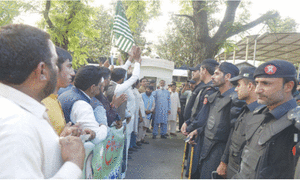While on one of my tours to Azad Jammu and Kashmir, all the way up to the Neelum Valley, I heard about a daak bungalow in Barsala from a concierge at one of the tourist lodges.
The historical and sentimental value of the Barsala Tourist Lodge was that Jinnah had stayed there for some time while on his way to Srinagar from Rawalpindi on July 26, 1944.
Also known as the Quaid-i-Azam Memorial Rest House, the lodge is located at a distance of 100km from Islamabad and 40km from Murree. On the way to Muzaffarabad, it is only 3km from the Kohala Bridge, which is the entry point to AJK.
The lodge, like most buildings in Kashmir, suffered damage during the 2005 earthquake, but the AJK Tourism Department has repaired the structure and its numerous rooms are open for tourists wanting to break the journey and stay at this serene place.
As our jeep made the descent from Muzaffarabad — the capital of AJK — towards Murree, my curiosity to explore the lodge where Jinnah had stayed gained momentum.
The roads grew broader and smoother the closer we got to Barsala, the treacherous twists and turns reduced in number, the sun played hide and seek, momentarily disappearing behind the curiously-shaped clouds.
It left us to enjoy the soothing shade, just before springing out from behind the clouds, bathing us in the bright light.
On one side of the road winding through the mountains was the splendid Jehlum River, roaring in all its majesty. Its waves crashed the rocky banks, occasionally spraying us with cool froth.
Stretched in front of us were the distant Himalayan mountains in all their majestic grandeur.
Soon enough, the jeep came to a halt at a by-road, jolting me out of my reverie. It seemed like we had arrived at the daak bungalow. Only, it was nowhere to be seen.
I blinked, waiting for it to appear before my eyes, when I saw the driver pointing somewhere a few feet down. I gasped as I gazed in awe at the loveliest lodge I had seen in a while.
It wasn’t the glamour of the building that robbed me of speech, but it was its perfect elegance and sophistication that mesmerised me.
The lodge was settled cosily in a clearing some feet above the now calm Jehlum River and a bit further down the main road.
Slightly secluded from view and very close to nature, this beautiful place located perfectly was totally befitting of the great leader’s standards.



Mossy stairs with tiny mushrooms growing out of them led me down to the wooden gate and into the lodge.
The whole place seemed like it was slumbering. At the sound of my family’s chatter, however, Abdullah, the concierge, came rushing out to greet us.
He welcomed us warmly and offered us tea, displaying the usual hospitality of Kashmiris.
When we told him that we weren’t there to stay but had come to visit the place out of our attachment to Jinnah, he got emotional — and I got a glimpse of the devotion he had for the lodge.
He told us that the room where Jinnah had stayed had been turned into a museum; it was opened only for visitors who wanted to take a look at the famed room. There was a plaque outside it with a description of the historic visit.
The sitting room, attached to the bedroom, was simple and elegant, with furniture of the finest quality.
Decades-old furniture with its gleaming surface looked good as new because Abdullah kept it spotlessly clean.
The bedroom contained a heavy wooden dressing table, a wardrobe and bed with an intricately carved headboard, like an embroidered crown.

In the sitting room, I spotted a rocking chair, which as Abdullah told, Jinnah had mostly rested upon.
We spent a few minutes in the room, taking in the surroundings and committing them to memory. Abdullah led us through a beautiful veranda with a grassy lawn running adjacent to it, into the drawing room where he showed us old pictures of the daak bungalow and those during and after its renovation.
After taking pictures and enjoying the beautiful view of the mountains and River Jehlum offered by the lodge, we thanked Abdullah, who courteously saw us off to our vehicle.
We left with the precious memories of the place that, I think, is nearly as valuable as the now restored Ziarat Residency.
Have you visited little known yet historically important places? Share your adventures with us a blog@dawn.com
















































